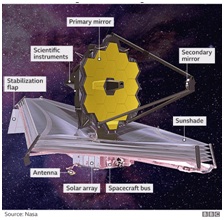

Context
James Webb Space Telescope (JWST) has been launched on 25th December 2021, from the French Guiana, on the northeast coast of South America, on the European Ariane 5 rocket.
Background
- There has always been curiosity to know about the origin of universe, stars, planets and how they die. This has led to the launch of large telescopes in space to observe light coming from objects, stars or galaxies which began its journey millions of years earlier.
- Hubble space telescope was launched by NASA in 1990 and now, James Webb telescope was launched. However, it is far better than its predecessor Hubble space telescope in the following ways-
- It is 100 times more powerful, has more infrared resolution and sensitivity than Hubble space telescope.
- It has a mirror surface area which is roughly six times larger than that of the Hubble Space Telescope, and so it has the ability to see some of the earliest objects to form after the big bang.

Analysis
What is James Webb Space Telescope (JWST)?
- JWST is a general-purpose observatory with a large aperture telescope optimised for infrared observations and a suite of state-of-the-art astronomical instruments capable of addressing many outstanding issues in astronomy.
- It was named after former administrator of NASA James E. Webb. It was launched as an international collaboration between NASA, ESA (European Space Agency) and the Canadian Space Agency. It costs around $9.7 billion, and is billed as the next-generation space telescope (NGST).
- Key features of JWST are-
- JWST will operate in an orbit around the Earth-Sun L2 Langrage point, ~ 1.5 million kilometres away from Earth. This makes its operation, pointing and stability requirements much simpler in comparison with HST
- It orbits around the Earth at an altitude of ~570 km above it.
- The telescope and the instruments will operate at the extremely low temperature of -233°C, which prevents the instrument's own infrared emission from overwhelming the signals from the astronomical targets
|
What is L2 point?
|
James Webb Space Telescope (JWST) Observatory
The JWST observatory includes three main elements-
- the Integrated Science Instrument Module (ISIM)
- the Optical Telescope Element (OTE)
- the Spacecraft Element which comprises the spacecraft bus and the sunshield

Potential benefits of the JWST Mission-
The launch of JWST is touted as the next big event in study of space events. It has the potential to explore following thing in universe-
- Universe's first galaxies-
- It is possible to observe different life stages of galaxies and stars by observing light emitted by the galaxies in time space.
- Reveal the birth of stars and planets and how they die
- Look for exoplanets with the potential for life-
- If life exists outside of Earth, it will release distinct chemical signatures, such as by breathing carbon dioxide and photosynthesizing out oxygen that can transform a planet. Analysing the chemicals in a planet’s atmosphere will not only allow scientists to look for life, but also enable them to assess a planet’s habitability.
- Study black holes from a different angle-
- Nothing can escape a black hole, not even light. But there is a plenty of stuff that revolves around stars i.e. stars, dust and entire This telescope will allow scientists to see different goings particularly the cooler gases.
Way forward-
Astronomers across the world are waiting for the telescope to reach its planned destination and start its findings. With its 5-10 years long life cycle, it has a lot of potential which needs global cooperation, collaboration and analysis, thus leading to growth of knowledge.

